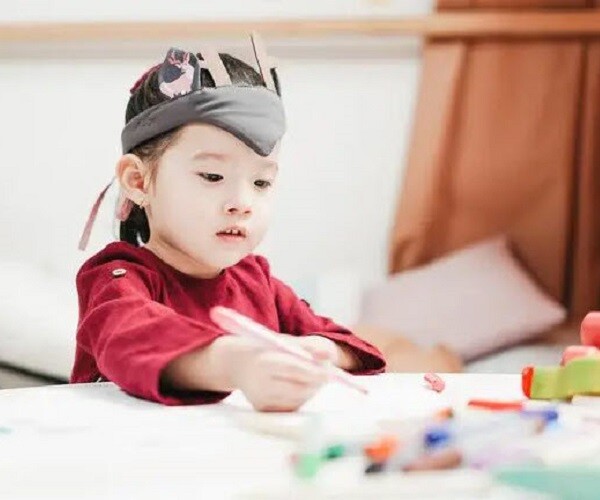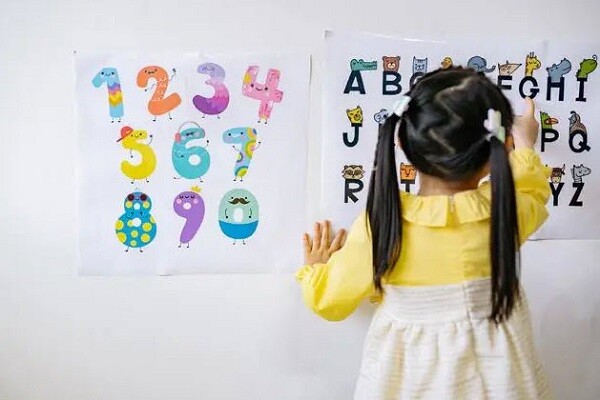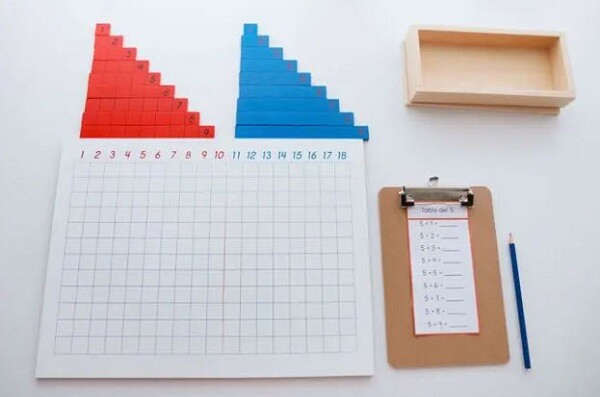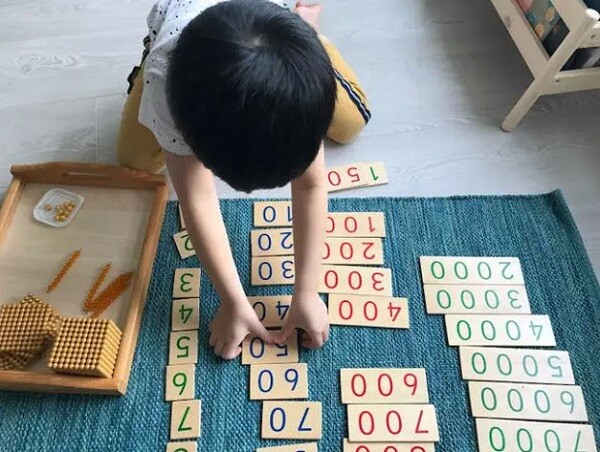Parents who want to introduce numbers to their children can incorporate educational games at home, making it easier for children to remember. For instance, using colorful geometric blocks to teach children number recognition or playing counting games with household items allows children to absorb knowledge naturally.
An education specialist suggests ways to help children become more familiar with numbers, emphasizing the importance of learning through hands-on experiences. Children will be introduced to wooden blocks, counting beads, or number cards, allowing them to explore and better understand mathematical concepts.


Understanding the Correspondence Between Numbers and Quantity
Parents can use a number spindle box to help children become familiar with numbers, giving them a clearer visualization of the digits. The spindle box consists of two boxes, each with five compartments labeled from 0 to 9. The main spindle includes 45 wooden rods, each representing one unit.
When guiding children on how to play, start with the number 1. For example, have the child pick up one rod, place it in the compartment labeled “1,” and say: “This is 1.” Then, pick up two rods and place them in the compartment labeled “2,” saying: “This is 2.” This process helps children recognize numbers and grasp the concept of quantity through practical manipulation.
Once all the rods are placed in the compartments from 1 to 9, you’ll notice there are no more rods left. At this point, you can go back to the initial number 0 and say to the child: “Zero doesn’t mean anything, so we don’t need to put any rods in the compartment marked 0.” This seemingly simple action can help children understand abstract numbers and associate numbers with quantities one-to-one.
Explaining the concept of zero is especially important. If a strong foundation is not laid, children may struggle with understanding equations like 5 + 0 or 5 – 0 in the future. Parents can also use disposable cups and straws instead of the spindle box and rods.
Additionally, parents can create various engaging activities to practice quantity recognition. For instance, organize counting games involving household items or objects in the park, or use everyday items like fruits, marbles, or toys for counting and sorting practices.

Understanding the correspondence between numbers and quantity.

Learning to Count Numbers Greater than 10
When children learn to count, they tend to grasp numbers smaller than 10 (or 20) more easily. Since these numbers are not large, parents often use fruits, candies, or cookies to help their children practice counting. Using tangible items like fruits and snacks makes it easier for children to visualize, making learning fun and engaging. Even if the child couldn’t count before, they would still count on their fingers when performing addition.
Parents can also use beaded rods. Simply put, these are rods with beads threaded onto a thin wire. Each rod has a minimum of one bead and a maximum of ten beads.
While many children can count from 1 to 100, they may not fully understand what 30 or 60 represent. The difference between 72 and 27, for instance, may only be in the order of the digits, without a clear understanding of their actual values.

Learning numbers greater than 10.
However, when playing with beaded rods, children can see that 30 is the same as three rods of ten beads each, and 60 is equal to six rods of ten beads each. This helps them grasp the concept of the decimal system and understand that the latter number is double the former.
Even though 72 and 27 differ only in the sequence of digits, they are distinct in quantity. If children can frequently touch and count the beaded rods while also practicing corresponding number exercises, they will develop a stronger sense of numbers. This leads to a deeper and clearer understanding of each number’s value, reducing the likelihood of confusion between them.

Learning Simple Addition and Subtraction
Teaching preschoolers addition and subtraction through daily life activities helps them grasp mathematical concepts, making learning fun and comprehensible.
If a child can quickly and accurately perform addition and subtraction within 20 in preschool, parents will feel more confident about their child’s mathematical foundation. On the other hand, if the child continues to make mistakes with these types of questions after entering elementary school, parents may become concerned about their child’s academic abilities.
In reality, if a child struggles with addition and subtraction, it may not be the child’s fault. It could also be due to an unsuitable learning method.
Here are some additional everyday activities parents can use to teach their children about addition and subtraction.

Learning simple addition and subtraction.
– During grocery shopping, have your child count the number of fruits, vegetables, or toys in the cart. For example: “We have 3 apples, and you want to add 2 more. So, how many apples do we have in total?”
– While eating, a parent can ask: “We have 5 cookies. If I give you 2, how many are left?” Or, “If you eat 1 cookie, how many are left for your friend?”
– Play games like “Find and Count” in the park. Ask your child to find and count objects around them (such as flowers, leaves, or rocks)
– Use chess or similar games where the child can move the pieces and count the number of moves. This helps them understand addition and subtraction by calculating the number of moves.
– Give your child some beads and ask them to string the beads according to the given quantities. For example: “String 4 red beads and 3 blue beads. How many beads do you have in total?”
– During art time, ask your child to draw a few shapes and then count them. You can prompt: “If you draw 2 more squares, how many squares will we have in total?”



































